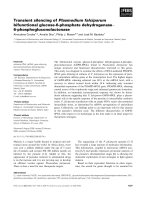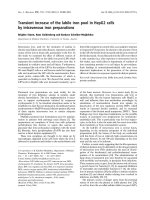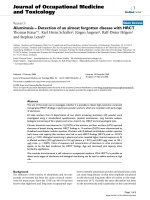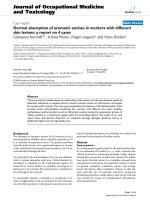Báo cáo hóa học: " Transient expression of homologous hairpin RNA interferes with PVY transmission by aphids" docx
Bạn đang xem bản rút gọn của tài liệu. Xem và tải ngay bản đầy đủ của tài liệu tại đây (226.2 KB, 5 trang )
BioMed Central
Page 1 of 5
(page number not for citation purposes)
Virology Journal
Open Access
Short report
Transient expression of homologous hairpin RNA interferes with
PVY transmission by aphids
Marisol Vargas, Belén Martínez-García, José Ramón Díaz-Ruíz and
Francisco Tenllado*
Address: Departamento de Biología de Plantas, Centro de Investigaciones Biológicas, (CIB, CSIC) Campus de la Ciudad Universitaria, Av. Ramiro
de Maeztu 9, 28040 Madrid, Spain
Email: Marisol Vargas - ; Belén Martínez-García - ; José Ramón Díaz-
Ruíz - ; Francisco Tenllado* -
* Corresponding author
Abstract
Hairpin RNAs have been used to confer resistance to viruses in plants through RNA silencing.
However, it has not been demonstrated that RNA silencing was effective against inoculation by
aphids of non-persistently transmitted viruses, the major route of plant virus spread in nature. As
a proof-of-principle strategy, we made use of Agrobacterium tumefaciens to transiently express a
hairpin RNA homologous to Potato virus Y (PVY) in plant tissues. A complete and specific
interference with aphid transmission of PVY was achieved by inducers of RNA silencing, as
demonstrated by specific siRNAs accumulation in agroinfiltrated tissues. To our knowledge, this is
the first report of successful interference with non-persistent transmission of a plant virus using
RNA interference.
Findings
One of the most efficient mechanisms by which plants
protect themselves from viruses is the specific RNA-
dependent silencing pathway termed post-transcriptional
gene silencing (PTGS). In certain circumstances, the RNA
silencing machinery recognizes several features of viral
infections involving the formation of double-stranded
(ds) RNA and initiates a response that degrades viral RNA
and eventually enables the plant to recover from virus
infection [1]. This principle can be manipulated by bio-
technologists to confer resistance to crops against virus
diseases in several ways. Several studies have demon-
strated that inverted repeat constructs encoding self-com-
plementary RNAs (hairpin RNAs) can effectively induce
RNA silencing and lead to high resistance frequencies in
transgenic plants [2,3]. However, questions concerning
the potential ecological risk of virus-resistant transgenic
plants, including genetic flow and reversal of silencing by
viral suppressors, have so far significantly limited its use
[4]. As an alternative approach, we and others have previ-
ously shown that exogenously supplied dsRNA, or vectors
expressing it, derived from viral sequences can specifically
interfere with virus infection in non-transgenic plants [5-
7]. It was proposed that the effect mediated by direct
application of dsRNA onto plant surfaces concurrent to
mechanical inoculation of the virus resembles the analo-
gous phenomenon of RNA interference (RNAi) observed
in animals [8,9]. The interfering dsRNA would mimic
double-stranded forms of RNA produced during virus rep-
lication, triggering the initiation step of PTGS. This may
lead to the production of 21 to 24 nucleotides duplexes
(small interfering RNAs, siRNAs) which are incorporated
Published: 19 March 2008
Virology Journal 2008, 5:42 doi:10.1186/1743-422X-5-42
Received: 29 January 2008
Accepted: 19 March 2008
This article is available from: />© 2008 Vargas et al; licensee BioMed Central Ltd.
This is an Open Access article distributed under the terms of the Creative Commons Attribution License ( />),
which permits unrestricted use, distribution, and reproduction in any medium, provided the original work is properly cited.
Virology Journal 2008, 5:42 />Page 2 of 5
(page number not for citation purposes)
into a nuclease complex responsible for the degradation
of the cognate viral RNA [1]. Thus, the invading virus con-
taining sequences homologous to the dsRNA is recog-
nized and degraded by the plant's defence mechanism.
This non-transgenic, RNAi-based approach could form
the basis for the development of a new biotechnological
tool aimed at protecting crops against virus diseases [9].
Aphid transmission is the main method of spread for
most plant viruses in nature including members of the
genus Potyvirus, the largest group of plant viruses. These
viruses are transmitted in a non-persistent manner, a cat-
egory of non-circulative transmission also known as
stylet-borne [10]. Since the RNAi-based approach in non-
transgenic plants has only so far been demonstrated
against mechanically inoculated viruses, we sought to
expand this resistance against virus inoculation by aphids.
As a proof-of-principle strategy, we made use of Agrobacte-
rium tumefaciens to transiently express hairpin RNA mole-
cules in plant tissues. The Agrobacterium-mediated
transient expression system has previously been used to
deliver RNA silencing inducers and suppressors into
plants [11]. We previously showed that transient expres-
sion of a hairpin RNA could block multiplication and
spread of a tobamovirus delivered by mechanical inocula-
tion in non-transgenic plants [12]. However, it is not
known if transient expression of hairpin RNA could block
virus transmission by aphids. In the present study, we
investigated the silencing potential of inverted repeat
sequences designed to generate a hairpin RNA homolo-
gous to Potato virus Y (PVY) for its ability to interfere with
the non-persistent transmission of this virus by aphids.
The commercial plasmid pCAMBIA2300 (CAMBIA) was
used to express in planta the inverted-repeat RNA corre-
sponding to coat protein (CP) gene sequences of PVY.
First, the cauliflower mosaic virus (CaMV) 35S promoter
was extracted from pAVA393 [13] using EcoRI, and ligated
to a derivative of pCAMBIA2300 in which the 3' termina-
tor region of the nopaline synthase gene (NOSt) was
inserted between PstI and HindIII sites. The viral
sequences were then extracted from pBKS-IRCPPVY using
KpnI and BamHI and introduced into the pCAMBIA2300
derivative to generate pIRCPPVY. To prepare pBKS-IRCP-
PVY, a fragment of plasmid pBSK-CPPVY [14] was ampli-
fied by polymerase chain reaction (PCR) using primers 5'-
TCCTCTAGA
CACTGAAATGATGG-3' and 5'-CTTGGTAC-
CGGAGAGACACTACATC-3', corresponding to positions
8509–8523 and complementary to 9374–9390, respec-
tively (italized), in the PVY genome [15]. An XbaI and
KpnI restriction sites (underlined) were created in both
primers, respectively, to facilitate further cDNA cloning in
a triple-ligation reaction: the PCR product was cut with
XbaI-KpnI; pCB278, a plasmid harbouring the phleomy-
cin resistance gene [7], was cut with HindIII-XbaI and both
fragments were ligated to the KpnI-HindIII cut pBSK-
CPPVY to obtain pBKS-IRCPPVY. Sequencing confirmed
the correct ligation of the three components. pBKS-IRCP-
PVY then incorporates a bacterial gene as a spacer
sequence between the sense and the antisense orienta-
tions of the PVY CP sequence. We took advantage of the
positive selection conferred by this prokaryotic resistance
gene to reduce the risk of intramolecular homologous
recombination in bacteria. Upon transcription, RNA from
pIRCPPVY is intended to fold into a stem-loop structure
consisting of 881 bp of PVY dsRNA and approximately a
500 bp spacer sequence (IRCPPVY, Fig. 1A). For compari-
son, one additional construct containing inverted repeat
sequences corresponding to the Pepper mild mottle virus
(PMMoV) polymerase gene (IR54PMMoV) [7] was used.
An empty pCAMBIA2300 was also used as a negative con-
trol. The binary plant vectors were introduced into Agro-
bacterium tumefaciens GV2260 by triparental mating and
the infiltration of plant tissues was performed essentially
as described by Tenllado et al. [7].
We determined first whether transient IRCPPVY expres-
sion could trigger an antiviral response in plants against
mechanically inoculated PVY. Nicotiana benthamiana
plants were infiltrated with A. tumefaciens cultures carry-
ing IRCPPVY or the empty vector. At 4 days post-infiltra-
tion, plants were challenge-inoculated by applying 20 μl
of PVY sap inoculum (1/10 w/v) on the infiltrated leaves
dusted with Carburundum. Plants were kept in growth
chamber with a 16 h light/8 h dark cycle at 25°C. By 7
days post-inoculation (dpi), mosaic symptoms were dis-
played by PVY-inoculated plants that had been infiltrated
with Agrobacterium carrying the empty vector. In contrast,
inoculated plants that had been infiltrated with IRCPPVY
remained symptomless throughout the entire testing
period (2 months). Analyses of viral CP accumulation
were performed by dot blot analysis (Fig. 1B). Plant
extracts were prepared by homogenizing leaf tissue in
phosphate-buffered saline, pH 7.4 (PBS) (5 ml/g) and
clarified by centrifugation at 10,000 rpm for 5 min. 10 μl
of extracts diluted in 200 μl of PBS were applied to poly-
vinyledene difluoride (PVDF) membranes (Amersham)
using a Bio-dot SF microfiltration apparatus (BioRad),
and washed twice with PBS. The sensitivity was increased
by incubating the membranes in acetone for 1 min, prior
to reaction with the specific antiserum. A specific rabbit
antiserum against PVY [14] was used at 1:1,000 in PBS
containing 5% nonfat milk and 0.05% Tween 20. Blots
were washed with PBS and incubated with peroxidase-
conjugated goat antirabbit IgG (GARPO) diluted 1:15,000
in PBS containing 5% nonfat milk for 1 h at room temper-
ature. Blots were washed twice with PBS and enzyme
activity was detected with an enhanced chemilumines-
cence kit (ECL, Amersham). Dot blot analysis of total sol-
uble proteins extracted from systemic leaves at 14 dpi
Virology Journal 2008, 5:42 />Page 3 of 5
(page number not for citation purposes)
showed that PVY CP accumulated in plants that had been
infiltrated with the empty vector at comparable levels to
PVY-inoculated plants that had not been infiltrated with
Agrobacterium. In agreement with the lack of symptoms,
PVY CP was not detected in the upper leaves of plants
infiltrated with IRCPPVY in any of the ten plants used in
the assay. These results suggest that transient expression of
PVY hairpin RNA is competent to trigger an antiviral
response against mechanically transmitted virus.
In a set of new experiments, leaves of N. benthamiana
plants were agroinfiltrated with cultures of Agrobacterium
carrying IRCPPVY, IR54PMMoV or the empty vector con-
structs. At 4 days post-infiltration, agroinfiltrated leaves
were used in plant-to-plant transmission tests. Groups of
apterous mature aphids from a Myzus persicae (Sulzer)
clone were collected, starved for a period of 2–3 h and
allowed to probe for 5–10 min on leaves of PVY-infected
N. benthamiana plants. Aphids (10–15 per plant) were
released onto an agroinfiltrated leaf covered with a plastic
bag at 4 days post-infiltration for inoculation over a 2 h
period before spraying with pirimicarb at 0.05% (w/v).
Plants were transferred to the growth chamber for obser-
vation. The results (Table 1) showed that transiently
expressed IRCPPVY was able to block transmission of PVY
(0% transmission rate), while aphids fed on plants infil-
trated with the empty vector transmited the virus at high
efficiency (100% transmission rate). Sixteen out of sixteen
plants infiltrated with Agrobacterium containing the empty
vector displayed disease symptoms in upper leaves at 7
dpi, whereas all plants (16 plants in 2 independent exper-
iments) that had been agroinfiltrated with the IRCPPVY
construct were free of symptoms until their life cycles were
completed. Dot blot analysis confirmed the visual obser-
vations of the accumulation of PVY CP in upper leaves at
14 dpi (Fig. 1C). PVY CP was not detectable in plants infil-
trated with IRCPPVY, whereas viral CP was abundant in
plants infiltrated with Agrobacterium containing the empty
vector. The interfering activity on PVY transmission exhib-
ited by transiently expressed IRCPPVY could reflect any
kind of unspecific, defence response of plants elicited by
hairpin RNA sequences that could somehow block the
transmission process. However, Agrobacterium-mediated
expression of a hairpin RNA derived from a heterologous
virus, IR54PMMoV, had no detrimental effect on PVY
transmission by aphids (Table 1). These results suggest
that interference with virus transmission by inverted
repeat sequences was sequence-specific and likely due to
the activation of RNA silencing.
To further test whether interference with aphid transmis-
sion conferred by transient expression of hairpin RNA
could be attributable to PTGS, the low molecular weight
RNA fraction was extracted from non-inoculated, Agrobac-
terium-infiltrated leaves and analysed by Northern blot
hybridisation as described [16]. A
32
P-labeled probe spe-
cific for the PVY CP sequence cloned in pBSK-CPPVY was
produced by random priming. siRNA species characteris-
tic of PTGS were detected in plants that had been infil-
trated four days before with IRCPPVY but were absent in
empty vector-infiltrated plants (Fig. 1D).
We have demonstrated that transient expression of an
antiviral hairpin RNA by A. tumefaciens results in resist-
ance to PVY transmission by aphids. Several studies have
Detection of PVY CP and PVY small interfering RNAs in N. benthamiana agroinfiltrated tissuesFigure 1
Detection of PVY CP and PVY small interfering
RNAs in N. benthamiana agroinfiltrated tissues.(A)
Schematic representation of pIRCPPVY used for transient
expression by agroinfiltration. A cDNA fragment encoding
sense and antisense PVY CP RNA sequences separated by a
spacer sequence (Phe) were cloned into binary plant vector
pCAMBIA2300. (B) Plants were agroinfiltrated with empty
vector or pIRCPPVY and used after 4 days post-infiltration to
inoculate PVY. Where no agroinfiltration occurred (right
panel), plants were directly inoculated with PVY (PVY) or
buffer (healthy). (C) Plants were agroinfiltrated with empty
vector or pIRCPPVY and used after 4 days post-infiltration to
feed viruliferous aphids (M. persicae). At 14 dpi., sap extracts
from upper leaves of single plants were assayed by dot blot
using PVY antiserum, and detected using a secondary anti-
body conjugated to peroxidase. (D) Northern blot analysis
of low molecular weight RNAs shows the accumulation of
siRNAs in pIRCPPVY-infiltrated leaves. Samples were taken 4
days after infiltration. The blot was hybridised with a
32
P-
labeled cDNA PVY CP probe. Equivalent loading of samples
was shown by staining the gel with ethidium bromide before
transfer. The mobilities of oligodeoxynucleotides of the indi-
cated length are shown to the right.
Empty vector
pIRCPPVY
Empty vector
pIRCPPVY
PVY
Healthy
B
25 nt25 nt
21 nt
D
C
A
NOSt
35S
EcoRI
PstI
HindIII
35S
KanR
CaMVt
LB
RB
EcoRI
KpnI BamHI
pIRCPPVY
PhePVY CP
EcoRI EcoRI
KpnI
CP PVY
Empty vector
pIRCPPVY
Virology Journal 2008, 5:42 />Page 4 of 5
(page number not for citation purposes)
indicated that inverted repeat constructs of transgenes can
effectively induce RNA silencing and protect plants
against viruses, including PVY, transmitted mechanically
[2,3]. However, it was not formally demonstrated that
silencing triggered by hairpin RNA was effective against
inoculation by aphids of non-persistently transmitted
viruses, the major route of virus spread in nature. Here, it
is shown that a complete and specific interference with
aphid transmission of PVY can be achieved by inducers of
RNA silencing, as suggested by specific siRNAs accumula-
tion in agroinfiltrated tissues. The available evidence indi-
cates that Agrobaterum-mediated expression of constructs
driven by the 35S promoter occurs in virtually every N.
benthamiana cell, including the epidermal and mesophyll
cell layers where inoculation of non-persistently transmit-
ted viruses by aphids take place [17]. As a result, PVY hair-
pin RNA is converted into siRNAs that guide sequence-
specific cleavage of the incoming, homologous viral RNA.
Wang et al. [18] reported resistance in barley transgenic
plants expressing Barley Yellow Dwarf Virus (BYDV)-hair-
pin RNA to the transmission of this virus by aphids. BYDV
is a persistently transmitted, circulative virus and thus rep-
resents a different transmission mechanism, with distinc-
tive impact on plant virus epidemiology, to that of PVY
[10]. Since inoculation by aphids of BYDV and potyvi-
ruses occurs in different cell layers (phloem vs. epider-
mis), features of the silencing response required to
achieve interference with transmission might differ.
Once having established the principle that RNAi is a
highly efficient approach to interfere with the non-persist-
ent transmission of plant virus by aphids, we envision
extending the non-transgenic, RNAi-based approach to
confer protection against aphid-borne viruses by directly
delivering dsRNA to plants [9]. Several expression systems
have been developed for the production of dsRNA in bac-
teria that could scale-up and speed the cost-effective pro-
duction of viral-derived interfering molecules [7,19]. In
order to enhance the therapeutic efficacy of RNAi against
aphid transmission of viruses, new and better strategies
for delivery of dsRNA to plant tissues have to be devel-
oped. Beyond this therapeutic application for plant pro-
tection, hairpin-dependent interference with virus
transmission by transiently expressed constructs provides
a potential tool to further dissect the molecular mecha-
nisms of aphid transmission. Expression of hairpin RNAs
driven by tissue-specific regulatory sequences could be
employed to abort virus multiplication at specific plant
cell layers and study their consequences for non-persistent
and other types of transmission processes.
Competing interests
The author(s) declare that they have no competing inter-
ests.
Authors' contributions
JRDR, FT; Design and conception of study. MV;cloning
cDNA constructs and dot blot analysis. MV, BM-G; trans-
mission assays. FT; manuscript preparation. All authors
read and approved the final manuscript.
Acknowledgements
We are grateful to Tomás Canto and César Llave for critical reading and
helpful comments on the manuscript. MV was supported by doctoral fel-
lowships from CONICYT-BID (Chile). This work was supported by grant
BIO2006-10944 from CICYT-MEC (Spain).
References
1. Voinnet O: Induction and suppression of RNA silencing:
insights from viral infections. Nat Rev Genet 2005, 6:206-220.
2. Chen Y-K, Lohuis D, Goldbach R, Prins M: High frequency induc-
tion of RNA-mediated resistance against Cucumber mosaic
virus using inverted repeat constructs. Molecular Breeding 2004,
14:215-226.
3. Smith NA, Singh SP, Wang MB, Stoutjesdijk P, Green A, Waterhouse
PM: Total silencing by intron-spliced hairpin RNA. Nature
2000, 407:319-320.
4. Tepfer M: Risk assessment of virus-resistant transgenic plants.
Annu Rev Phytopathol 2002, 40:467-491.
5. Pooggin MM, Shivaprasad PV, Veluthambi K, Hohn T: RNAi target-
ing of DNA virus in plants. Nat Biotechnol 2003, 21:131-132.
6. Tenllado F, Díaz-Ruíz JR: Double-stranded RNA-mediated
interference with plant virus infection. J Virol 2001,
75:12288-12297.
7. Tenllado F, Martinez-García B, Vargas M, Díaz-Ruíz JR: Crude
extracts of bacterially expressed dsRNA can be used to pro-
tect plants against virus infections. BMC Biotechnology 2003, 3:3.
8. Fire A, Xu S, Montgomery MK, Kostas SA, Driver SE, Mello CC:
Potent and specific genetic interference by double-stranded
RNA in Caenorhabditis elegans. Nature 1998, 391:806-811.
9. Tenllado F, Llave C, Díaz-Ruíz JR: RNA interference as a new bio-
technological tool for the control of virus diseases in plants.
Virus Res 2004, 102:85-96.
Table 1: Interference with PVY transmission by Agrobacterium tumefaciens-mediated transient expression of IRCPPVY.
Agroinfiltrated
a
Experiments Total
b
Percentage transmission
Empty vector 2 16/16 100
pIRCPPVY 2 0/16 0
pIR54KPMMoV 1 8/8 100
a
N. benthamiana leaves were agroinfiltrated with the indicated constructs, and used after 4 days post-agroinfiltration to feed viruliferous aphids (M.
persicae).
b
Plant-to-plant transmission experiments were performed, using 10–15 aphids per plant. Pooled transmission rates are indicated as number of
infected plants/number of test plants
Publish with BioMed Central and every
scientist can read your work free of charge
"BioMed Central will be the most significant development for
disseminating the results of biomedical research in our lifetime."
Sir Paul Nurse, Cancer Research UK
Your research papers will be:
available free of charge to the entire biomedical community
peer reviewed and published immediately upon acceptance
cited in PubMed and archived on PubMed Central
yours — you keep the copyright
Submit your manuscript here:
/>BioMedcentral
Virology Journal 2008, 5:42 />Page 5 of 5
(page number not for citation purposes)
10. Nault LR: Arthropod transmission of plant viruses: a new syn-
thesis. Ann Entomol Soc Am 1997, 90:521-541.
11. Johansen LK, Carrington JC: Silencing on the spot. Induction and
suppression of RNA silencing in the Agrobacterium-mediated
transient expression system. Plant Physiol 2001, 126:930-938.
12. Tenllado F, Barajas D, Vargas M, Atencio FA, González-Jara P, Díaz-
Ruíz JR: Transient expression of homologous hairpin RNA
causes interference with plant virus infection and is over-
come by a virus encoded suppressor of gene silencing. Mol
Plant-Microbe Interact 2003, 16:149-158.
13. von Arnim AG, Deng XW, Stacey MG: Cloning vectors for the
expression of green fluorescent protein fusion proteins in
transgenic plants. Gene 1998, 221:35-43.
14. Llave C, Martínez B, Díaz Ruíz JR, López Abella D: Serological anal-
ysis and coat protein sequence determination of Potato virus
Y (PVY) pepper pathotypes and differentiation from other
PVY strains. European J Plant Pathol 1999, 105:847-857.
15. Robaglia C, Durand-Tardif M, Tronchet M, Boudazin G, Astier-Mani-
facier S, Casse-Delbart F: Nucleotide sequence of Potato virus Y
(N Strain) genomic RNA. J Gen Virol 1989, 70:935-47.
16. Barajas D, Tenllado F, González-Jara P, Atencio FA, Martínez-García
B, Díaz-Ruíz JR: Resistance to Plum pox virus (PPV) in Nicotiana
benthamiana plants transformed with the PPV HC-Pro
silencing suppressor gene. J Plant Pathol 2004, 86:239-248.
17. Martin B, Collar JL, Tjallingii WF, Fereres A: Intracellular ingestion
and salivation by aphids may cause the acquisition and inoc-
ulation of non-persistently transmitted plant viruses. J Gen
Virol 1997, 78:2701-2705.
18. Wang MB, Abbott DC, Waterhouse PM: A single copy of a virus-
derived transgene encoding hairpin RNA gives immunity to
barley yellow dwarf virus. Mol Plant Pathol 2000, 1:347-356.
19. Aalto AP, Sarin LP, van Dijk AA, Saarma M, Poranen MM, Arumae U,
Bamford DH:
Large-scale production of dsRNA and siRNA
pools for RNA interference utilizing bacteriophage φ6 RNA-
dependent RNA polymerase. RNA 2007, 13:422-429.









